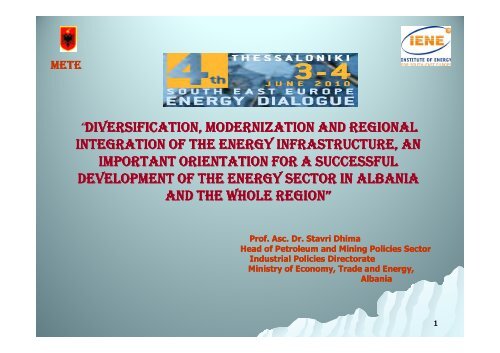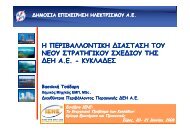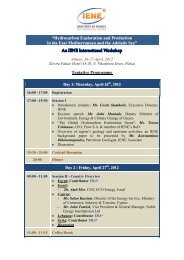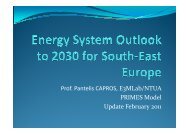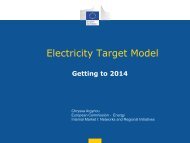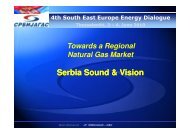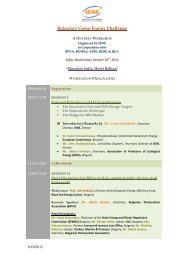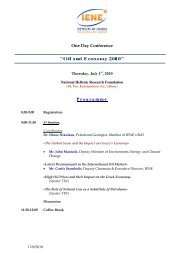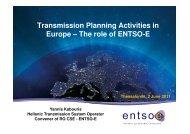Prof. Stavri DHIMA
Prof. Stavri DHIMA
Prof. Stavri DHIMA
Create successful ePaper yourself
Turn your PDF publications into a flip-book with our unique Google optimized e-Paper software.
METE<br />
METE<br />
“DIVERSIFICATION, DIVERSIFICATION, MODERNIZATION MODERNIZATION AND AND REGIONAL<br />
REGIONAL<br />
INTEGRATION INTEGRATION OF OF THE THE ENERGY ENERGY INFRASTRUCTURE, INFRASTRUCTURE, AN<br />
AN<br />
IMPORTANT IMPORTANT ORIENTATION ORIENTATION FOR FOR FOR A A SUCCESSFUL<br />
SUCCESSFUL<br />
SUCCESSFUL<br />
DEVELOPMENT DEVELOPMENT DEVELOPMENT DEVELOPMENT DEVELOPMENT OF OF OF OF OF OF OF THE THE ENERGY ENERGY SECTOR SECTOR IN IN ALBANIA<br />
ALBANIA<br />
AND AND THE THE WHOLE WHOLE REGION”<br />
REGION”<br />
<strong>Prof</strong>. Asc. Asc.<br />
Dr. <strong>Stavri</strong> Dhima<br />
Head of Petroleum and Mining Policies Sector<br />
Industrial Policies Directorate<br />
Ministry of Economy, Trade and Energy,<br />
Albania<br />
1
�� I. ENERGY SECTOR OVERVIEW<br />
�� II. II ENERGY COMMUNITY<br />
�� III. III ENERGY SITUATION IN ALBANIA<br />
�� IV IV. ENERGY INFRASTRCTURE<br />
�� �� IV<br />
CONTENTS<br />
IV.1. INFRASTRCTURE PROJECTS ON<br />
ON POWER POWER SECTOR SECTOR.<br />
INVESTMENTS IN TRANSISSION<br />
�� IV IV.2. INFRASTRUCTURE PROJECTS ON PETROLEUM SECTOR SECTOR<br />
�� V. DEVELOPING OF THE ENERGY INFRASTRCTURE<br />
� VI.- INSTITUTIONAL RELATIONS ON REGIONAL COOPERATIONS<br />
�� CONCLUSIONS<br />
2
I. ENERGY SECTOR OVERVIEW<br />
�The reforming, modernisation and strengthening of the national<br />
energy sector, represent one of the most important targets of Albania,<br />
in its way of developing and European integration.<br />
�The energy in general and sustainable energy in particular are<br />
becoming more and more sensitive topics and a big challenge to be<br />
overcome, in local and regional level and beyond.<br />
�The further modernization of the energy sectors in national<br />
level, in order “to guarantee the energy security of supply”, is a<br />
key objective for all SEE countries, and European countries, as well,<br />
towards their further social and economic development, as well as<br />
their regional integration.<br />
3
I. ENERGY SECTOR OVERVIEW<br />
� To face this situation the energy policy has to be addressed not<br />
only on the growing of energy sector resources in domestic level,<br />
but also developing of compressive synergies and close<br />
cooperation amongst all countries in the SEE Region, and<br />
on European level.<br />
�We believe that independently from the actual situation<br />
of our energy sector, the security of energy supply is<br />
depending more and more from the developments of<br />
energy networks and infrastructures in the regional level.<br />
�From the Albania Government point of view this objective<br />
has to be achieved by internally development of the energy<br />
sources and infrastructures, and further more, through<br />
strengthening the regional coordination and cooperation<br />
4
II. ENERGY COMMUNITY<br />
�The Establishing of the Energy Community Treaty is considered as a<br />
very important instrument to face the challenges and for the achievement<br />
of the main targets in the energy sector for the contracting Parties and for<br />
the whole region, In order to increase energy exchange and energy supply<br />
competition, as well as to enhance the security of energy supply in<br />
regional level,<br />
�As �As a Contracting Party of the Energy Community Albania has adopted<br />
its strategy and Action Plan supported by necessary legal and institutional<br />
framework.<br />
�The Action Plan of Albania aims towards fulfilling the Treaty’s<br />
requirements regarding energy network and energy market regulation,<br />
first of all for the security of energy supply and its integration to the<br />
Energy Community.<br />
MINISTRY OF ECONOMY, TRADE AND ENERGY<br />
JUNE, 2010<br />
5
III. ENERGY SITUATION OF ALBANIA<br />
�In general energy resources of Albania include some poor quantity of coal,<br />
crude oil, some quantities of natural gas and associated gas and o lot of hydro<br />
potentialities.<br />
�On the other side most of countries in the region, including EU members,<br />
like Greece and Italy, cannot satisfy their domestic energy demand by using<br />
only local resources. Some of them like Croatia, Montenegro, Kosovo and<br />
Macedonia, have also experienced an increasing of electricity imports.<br />
�The security of energy supply during these last years, first of all 2006-2009,<br />
has been mainly conditioned by insufficient power generation and transmission<br />
capacities, in regional level, due to generation decreases, monopolies and<br />
protection positions.<br />
�These regional insufficiencies, particularly in case of Albania, whose power<br />
generation is highly sensitive to weather conditions, translate into severe and<br />
repeated energy crisis, which can impede social and economic development<br />
of the country.<br />
6
III. ENERGY SITUATION OF ALBANIA<br />
�The Albanian oil demand of about 1,2 million toe, partially is<br />
covered by domestic production and partially by imports.<br />
�The import of oil by products for 2009 was more than 60 % of<br />
total consumption.<br />
�Due to the actual very low level of domestic gas production<br />
(about 9 million cm) and availability, gas system in Albanian has<br />
been practically out of use.<br />
�But gas is becoming more and more important due to socio and<br />
economic development impact of the country in general and Power<br />
Sector in particular.<br />
7
The location of main oil and gas field in Albania<br />
8
Historical Crude Oil Production and Consumption (Ktoe)<br />
2500<br />
2000<br />
1500<br />
1000<br />
500<br />
0<br />
1929<br />
1947<br />
Limestone<br />
Sendstone<br />
consumption<br />
1960<br />
1970<br />
1980<br />
1990<br />
2000<br />
2008<br />
9
III. ENERGY SITUATION OF ALBANIA<br />
�As regard the power sector, Albania is a very reach hydro<br />
resources country.<br />
�The hydro reserves are around 16 billion kWh per year, out of which<br />
we have exploited only 30-33 %.<br />
�The demand of electricity of about 6,5 billion kW is higher than<br />
year local generation, which means that Albania is an importer of<br />
electricity and in some cases more than 30 % of yearly consumption.<br />
�To cover our electricity needs we have to import more than 2 billion<br />
kW hours per year, through the interconnection capacities with<br />
neighbouring countries.<br />
10
THE ENERGY IMPORTS IN ALBANIA<br />
Import of energy products 1995-2008 (ktoe)<br />
11
RECENT MARKET DEVELOPMENTS<br />
•One combined cycle power<br />
generation plant of 97 MW<br />
convertible to NG and expandable<br />
up to 300 MW was completed<br />
near Vlora town in year 2009<br />
•Three Large capacity cement<br />
factories already functional in<br />
Albania.<br />
•A year consumption of LPG<br />
about 100 000 ton<br />
•Positive economic growth despite<br />
global crisis.<br />
12
IV. ENERGY INFRASTRCTURE<br />
�In close cooperation with our partners there are identified<br />
concrete projects in that extension, both in generation and<br />
transmission of electricity and some of them are now in place or<br />
under implementation phase.<br />
�There are identified concrete projects for the regional<br />
interconnection of Albania with oil and gas networks.<br />
�In this prospective, Albania seems to play an important role on<br />
the Energy Community transiting energy from Western Balkan to<br />
Western and Central Europe.<br />
13
IV.1. ENERGY INFRASTRCTURE<br />
Transmission System<br />
The Transmission System in Albania is<br />
composed of the 400, 220 and 110 kV<br />
level networks and has 120 km 400 kV<br />
lines, 1,103 km 220 kV lines, 34 km 150<br />
kV line and 1,202 km 110 kV lines.<br />
The 220 kV network is completely<br />
meshed and connects the main plants in<br />
the North of Albania with load centers in<br />
areas of Tirana, Elbasan and Fieri.<br />
The 110 kV network is used for the<br />
supply of the Distribution System. Part<br />
of this network is meshed and the other<br />
part is radial.<br />
The 12 substation 220 kV and 400 kV<br />
are generally constructed with double<br />
busbar in 220 kV and 400 kV side.<br />
The map with power plants,<br />
lines and substations<br />
14
IV.1. ENERGY INFRASTRCTURE<br />
The Albanian system is connected to<br />
neighbouring countries by the following<br />
interconnecting lines:<br />
400 kV between Zemlak and Kardhja<br />
(Greece)<br />
Rated power: 1200 MVA and Transmittable<br />
power: 700 MVA due to the 400/220 kV<br />
transformer at Elbasan2 and Zemblak.<br />
220 kV between Fierze and Prizren<br />
(Kosovo)<br />
Transmittable power: 311 MVA<br />
220 kV between Vau Dejes and Podgorica<br />
1 (Montenegro)<br />
Transmittable power: 311 MVA<br />
150 kV between Bistrica 1 and Igumenice<br />
(Greece), used only in radial operation mode)<br />
er at Bistrice.<br />
The 400 KV System with Greece arrived<br />
up to 400/220 kV Elbasani substation and<br />
don’t closed the 400 kV ring with Monte<br />
Negro.<br />
15
IV.2. INFRASTRUCTURE<br />
ON THE PETROLEUM<br />
SECTOR<br />
Map of main oil and gas pipelines<br />
on the Albanian territory.<br />
16
IV.2. INFRASTRUCTURE ON THE PETROLEUM SECTOR<br />
Concerning oil and gas transportation and stockholding, the investments<br />
shall be made in several directions. directions<br />
�� Concerning<br />
�� There There are two new Oil Terminals on the Albanian seaside. seaside<br />
The Oil Terminal of “Porto – Romano” under the administration of the<br />
concessionary company company “Romano “Romano Port”. Port” (Operational since since June 2009 2009) 2009 2009)<br />
�� The<br />
The Oil Terminal of “Vlora Vlora Bay” under the administration of the<br />
concessionary company “La Petrolifera Italo Albaneze”sh<br />
Albaneze”sh.a. (Operational<br />
since June 2009 2009)<br />
�� The<br />
The Investments shall continue to increase the existing stockholding<br />
capacity and the relevant infrastructure of oil gas and their by by-products products in<br />
this area .<br />
�� The<br />
17
IV.2. INFRASTRUCTURE on the petroleum sector<br />
18
“Porto Romano” Port is built 6.5 km north of the city of Durres.<br />
The terminal will afford<br />
cargo ships with liquid<br />
gas capacity of 9.000<br />
tones<br />
and<br />
oil cargo ships with<br />
capacity of 20.000<br />
tones.<br />
Discharge capacity of<br />
the equipment is:<br />
4.000 tones per<br />
L.P.G / 24 hours<br />
9.000 tones oil<br />
(gasoline) 24<br />
/hours<br />
19
“Vlora 1” Port is built 3.5 km north of the city of Vlora<br />
Shore<br />
infrastructure<br />
50000 cbm for<br />
Petroleum Proucts<br />
4000 cbm for LPG<br />
Marine<br />
infrastructure<br />
600 m long quay<br />
Depth about 8,5 m<br />
Possible<br />
accommodation of<br />
two vessels<br />
20
V. DEVELOPING OF THE ENERGY INFRASTRCTURE<br />
Energy Statistics (Ktoe) Energy Forecast (Ktoe)<br />
2002 2006 2008 2010 2020 2030<br />
Gross Inland Consumption<br />
(GIC) 1730,4 1961,6 2094,9 2345,4 3985,0 5080,0<br />
Solids 20,6 18,0 23,0 24,0 62,0 105,0<br />
Oil 961 1171 1307 1455 2102 2420<br />
Natural Gas 8 10 8 8 603 1042<br />
Nuclear 0 0 0 0 0 0<br />
Electricity 166 53 209 220 78 110<br />
Renewable energy forms 575,3 710,0 548,0 638,4 1139,9 1403,0<br />
Net imports 834 727 941 1069 2484 3342<br />
Solids 16 3 3 4 40 80<br />
Oil 653 671 729 845 1772 2120<br />
- Crude Oil and Feedstock 160 170 180 220 0 0<br />
- Oil Products 493 501 549 625 1772 2120<br />
Natural Gas 0 0 0 0 594 1032<br />
Electricity 166 53 209 220 78 110<br />
Energy balances and indicators of Albania<br />
21
V. DEVELOPING OF THE ENERGY INFRASTRCTURE<br />
�These situations, on the Albanian Energy Infrastructure and<br />
necessity to improve the diversification of energy sources and<br />
interconnection with regional energy networks, well, have stressed<br />
the Government of Albania to establish developing policies and<br />
programs of the country and the economy, giving a specific priority to<br />
the strengthening of the energy infrastructure.<br />
�There are o lots of projects in the energy sector, identified in close<br />
cooperation with our neighbors and foreign partners to increase<br />
Albanian Power System interconnection capacities, and to link our oil<br />
and gas network with Eurasia energy resources and corridors and to play<br />
an important role in transiting energy to Western Europe Countries.<br />
22
V. 1. - INVESTMENTS IN ELECTRICITY PRODUCTION AND<br />
TRANSMISSION<br />
�The balance of the Albanian power system with alternative energy<br />
sources is a determinant factor for the sustainable economic<br />
development of the country, and for the future and its integration on<br />
the Energy Community, as well.<br />
�Actually are given on concession contracts the construction of Devolli<br />
River Cascade (installed capacity 319 MW), Ashta HPP (installed capacity<br />
48 MW), Kalivaçi HPP (installed capacity 93 MW), more than 160 small<br />
hydropower plants (installed capacity 344 MW), and several wind farms<br />
(with a installed capacity about 1500 MW).<br />
�We hope that after some years Albania will be able to cover the local<br />
demand and to be a real exporter of electricity on the region, as well.<br />
23
V. 1. - INVESTMENTS IN ELECTRICITY PRODUCTION<br />
AND TRANSISSION<br />
A number of projects to improve electricity<br />
supply in the medium and long term are are:<br />
Construction of Elbasan Elbasan-Tirana Tirana 2/Kashar Kashar-<br />
Podgorica (already (already under construction and<br />
financed by Italian Cooperacione and KfW KfW);<br />
400 kV transmission network identified<br />
projects are are:<br />
- 400 kV Interconnection between Albania<br />
and Kosovo, committed to be financed by<br />
KFW of<br />
of Germany)<br />
Germany)<br />
- 400 kV Substation (busbar busbar) Lezha<br />
Commutation Point Point.<br />
- 400 kV Substation (busbar busbar) Elbasan New<br />
Commutation Point<br />
-400 400 kV Interconnection between Albania<br />
and Macedonia - OHTL Elbasan New New-<br />
Macedonia Macedonia.<br />
-Albania Albania –Italy Italy HV undersea<br />
interconnection lines<br />
- Construction of the new<br />
Dispatching Center Center.<br />
24
V. 1. -<br />
INVESTMENTS IN<br />
ELECTRICITY<br />
PRODUCTION AND<br />
TRANSISSION<br />
In this regards can mention<br />
the 400 kV lines with<br />
Montenegro, Kosovo and<br />
Macedonia and Italy.<br />
25
ALTERNATIVES OF ALBANIA’S FUTURE<br />
N-G G SUPPLY<br />
� Eventual new HC discoveries. (HC exploration<br />
under way)<br />
�� Connection to the international pipeline N<br />
- G networks.<br />
� Construction of an LNG plant on the<br />
Albanian coast.<br />
26
Energy Community Gas Ring (Western Balkan<br />
Ring project) on the frame of regional projects<br />
27
Petroleum agreements on exploration<br />
Actually are under operation for the exploration oil and gas<br />
the following agreements:<br />
• Durresi block offshore, with the company<br />
ISLANDROCKALL Jv Jv. . And the Australian company<br />
Beach Petroleum Ltd<br />
• Joni 5 block offshore, with the company Medoil, which<br />
was bought by Cairn Energy company and the<br />
Agreement for this block is covered by the branch<br />
Capricorn Albania Ltd<br />
• A-B B blocks onshore and the Agreement on blocks D-E E<br />
onshore onshore, , with company DWM Petroleum AG<br />
• Blocks 2-3 2 3 onshore, with company DWM Petroleum<br />
AG<br />
• Block F with with Bankers Bankers-Petroleum Petroleum (under approval)<br />
• Until now in this activity is invested about 800 milion<br />
USD<br />
• The total amount of investment is expected to be 38<br />
million USD<br />
28
Energy and Industrial infrastructure project of<br />
Porto Romano (Durres), 810 ha<br />
29
Infrastructure Projects on petroleum sector<br />
�� Projects in the oil and gas pipeline and their<br />
infrastructure<br />
infrastructure<br />
• The Ionian Adriatic Gas Pipeline -IAP IAP Project<br />
• “Trans Adriatic Pipeline” (TAP Project)<br />
• LNG Terminal of the Trans European Energy BV sh.c on<br />
the Fieri District seaside.<br />
• On the project of the Trans Balkan Oil Pipeline (AMBO<br />
Project):<br />
30
A substantial „Regional Integrated Gasification - Initiative“ is the<br />
possible interconnection of Albania with regional gas market market.<br />
IAP<br />
LNG<br />
TERMINALS<br />
TAP<br />
IGI<br />
ECR<br />
31
WHY INTERNATIONAL NN-G<br />
G CONNECTIONS<br />
SHOULD TAKE ADVANTAGE FROM<br />
CROSSING ALBANIA ?<br />
• Albania is now a member of NATO and looks<br />
forwards the EU membership<br />
membership. .<br />
• Has historically been a factor of peace and stability<br />
in the region<br />
• Its excellent geographical position offers the shortest<br />
and therefore the most cost efficient link for N-G N G<br />
pipes from Caspian areas to Southern Italy<br />
• Has important capacities for underground storage<br />
• Despite its modest size the Albanian economy is<br />
growing steadily.<br />
32
Supply Options for the Gasification of ALBANIA<br />
��Option Option A: Supply of Albania with gas from Northern<br />
Balkan grid via Croatia towards towards Monte Negro (IAP<br />
project).<br />
IAP<br />
LNG<br />
Option D: Supply of Albania with LNG<br />
through the LNG Terminals on the Adriatic<br />
seaside in Fieri Region<br />
WBR<br />
IGI<br />
Option C: Supply of Albania with Russian gas<br />
via Serbia, FYRO Macedonia Macedonia, , (part of Western<br />
Balkan Ring project<br />
Option Option B:<br />
B: Supply of Balkan and<br />
Western European countries with gas<br />
from the Caspian Sea Region via Turkey<br />
and Greece to Southern Italy transit<br />
through Albania. (TAP project, IGI<br />
Project)<br />
TAP<br />
33
The Ionian – Adriatic gas Pipeline (IAP - Project)<br />
Signing of Ministerial Declaration for<br />
the IAP Project Project, , Zagreb 25<br />
September September 2007. Joint Declaration<br />
of B&H, Tirana on 11.12.2008.<br />
Benefits of IAP:<br />
�� Creates the preconditions of<br />
gasification of Albania and<br />
Montenegro (about 400 km)<br />
�� Facilities the gasification of South<br />
Croatia and a significant part of<br />
Bosnia and Herzegovina.<br />
�� Enables diversified supply<br />
�� Enables the access to Croatian and<br />
Albanian underground gas storage<br />
facilities.<br />
�� Enables the future interconnection<br />
with Greek and FYROM gas<br />
network.<br />
�� Enables significant transit and<br />
thereby profit to Albania,<br />
Montenegro and Croatia.<br />
�� Activates the economy of the whole<br />
region.<br />
34
New developments with TAP Project<br />
- The Trans Adriatic Pipeline (TAP)<br />
is a project being promoted by the<br />
Swiss Elektrizitats<br />
Elektrizitats-Gesellschaft<br />
Gesellschaft<br />
Laufenburg (EGL). (EGL)<br />
-EGL EGL signed an agreement in<br />
February 2008 with Norway’s<br />
StatoilHydro to establish a<br />
50 50/50 50 joint venture to build<br />
and<br />
and operate<br />
operate the<br />
the TAP TAP. TAP TAP. On On 20<br />
20<br />
May 2010 E On Rhurgas is the<br />
new shareholder of TAP<br />
Project. Project<br />
-The The project through a separate<br />
spur line along the Balkan coast<br />
towards Croatia (the Ionian- Ionian<br />
Adriatic Adriatic-Pipeline) Pipeline) –promote promote the<br />
development of a broader regional<br />
gas market in SEE.<br />
SEE<br />
35
Proposed LNG Terminal projects, Fieri Region<br />
LNG<br />
TERMINAL<br />
Proposed by<br />
EGL<br />
LNG<br />
TERMINAL<br />
Proposed by<br />
ASG Power<br />
LNG<br />
TERMINAL<br />
Proposed by TRANS<br />
EUROPEAN ENERGY<br />
BV<br />
�� Decision of the Council<br />
of Ministers no. 731,<br />
01.11.2006 “On On the<br />
approval of the study<br />
“For For the possibilities of<br />
construction of the<br />
liquefied natural gas<br />
(LNG) LNG) terminals and<br />
respective<br />
infrastructure, on the<br />
Fieri District seasisde”.<br />
�� Decision of the<br />
Albanian National<br />
Council of Territory<br />
Regulation, No. 1, date<br />
01. 03.2007 “For the<br />
approval of the study<br />
for the placement of<br />
the liquefied natural<br />
gas terminals and their<br />
respective<br />
infrastructure on the<br />
Fieri District seaside”.<br />
36
LNG Terminal project of the<br />
“Trans European Energy BV” sh.a.<br />
– The Contract of the Permit to the company “Trans<br />
European Energy BV” sh.a. for construction of the LNG<br />
Terminal on the Fieri District seaside, is signed on 02<br />
December 2008, in Tirana and is approved by the Council<br />
of Ministers.<br />
– The LNG Terminal will have the capacity about 8<br />
BCM/year, equal to more than 6 million ton natural gas<br />
per year.<br />
– The LNG Terminal will be capable to unloads ships with<br />
capacity up to 140.000 m3. On the plant will be instalated<br />
two cryogenic storage tanks with net capacity 140.000<br />
m3, each of them.<br />
37
Underground Gas Storage in Albania<br />
�� Albania has several suitable sites for for gas gas storage, storage, including, including, a salt<br />
dome in Dumrea (up to 2 bcm) bcm)<br />
and the depleted Divjaka gas field (up<br />
to 1 bcm).<br />
�� Based on a preliminary feasibility study, presented on the 3rd Gas<br />
Forum in Ljubljana, the possible UGS at Dumre Salt Dome could have<br />
the cheapest cost for gas storage (76$/ (76$/Mcm Mcm)<br />
�� Is possible the cooperation between Albania and Greece for using of<br />
UGS In Dumrea Salt Dome.<br />
�� By connecting these gas storage into regional gas network (including<br />
Energy Community Ring), Albania could provide regional storage<br />
facilities for other Balkan countries.<br />
�� Therefore Therefore the design of underground gas deposits deposits is a project of<br />
regional interest and with a particular importance for Albania.<br />
38
Location of possible underground gas storage.<br />
Dumrea Salt Dome and Divjaka Depleted Gas Field<br />
Depleted<br />
Gas Field<br />
of Divjaka<br />
Salt Dome<br />
in Dumrea<br />
39
POSSIBLE CONNECTION OF ALBANIA WITH THE REGIONAL<br />
OIL PIPELINE NETWORK<br />
�The main project on the connection of Albania with the<br />
regional oil pipeline network is the project on the Trans<br />
Balkan Oil Pipeline, Albania - Macedonia - Bulgaria –(AMBO<br />
project).<br />
�Concerning this project, the Trilateral Convention has<br />
already entered into force, as of 1 October 2007, which<br />
was approved by Law No. 9778, dated 16.07.2007, “On the<br />
ratification of the Trilateral Convention between the Republic of<br />
Albania, Republic of Bulgaria and the Republic of Macedonia, on<br />
the Trans Balkan Oil Pipeline system”<br />
�The propsed oil pipeline will have a capacity of 750 000<br />
crude oil barrels a day (around 37 million tons a year) and<br />
the total investment (for all of its length) for this project<br />
will be around 1,75 billion USD.<br />
�However, being of a regional strategic character, its<br />
progress is surely connected with the geopolitical<br />
developments in the region and further.<br />
40
POSSIBLE CONNECTION OF ALBANIA WITH THE REGIONAL<br />
OIL PIPELINE NETWORK<br />
The Trans Balkan Oil Pipeline, Albania - Macedonia - Bulgaria –(AMBO project)<br />
41
VI.- INSTITUTIONAL RELATIONS ON REGIONAL COOPERATIONS<br />
TO SUPPORT THE DEVELOPING OF THE ENERGY SECTOR AND THE<br />
REGIONAL ENERGY INTEGRATION LBANIA HAS SIGNED:<br />
•“The Agreement between the Council of Ministers of the Republic of Albania<br />
and the Republic of Italy concerning the development and integration<br />
of electrical and natural gas systems”, signed in Tirana, on 10.03.2009.<br />
•The Agreement between the Council of Ministers of the Republic of Albania<br />
and the Republic of Greece, “On cooperation in the energy field”,<br />
approved by DCM No 710, dated 18.10.2006, “On the approval of the<br />
Agreement, between the Council of Ministers of the Republic of Albania and<br />
the Republic of Greece, on cooperation in the energy field”.<br />
•Memorandum of Understanding between the Ministry of Energy and<br />
Mines of the Republic of Kosovo and the Ministry of Economy, trade and<br />
Energy of the Republic of Albania, on cooperation in the energy field,<br />
signed in Pristina, on 09.09.2008.<br />
•“The Ministerial Declaration on the Ionian – Adriatic Gas Pipeline<br />
Project”, between Croatia, Montenegro and Albania, signed in Zagreb<br />
(Croatia) on 25 September 2008. Bosnia&Herzegovina joined this<br />
Ministerial Declaration on 11 December 2008, during the Ministerial Meeting<br />
of the Energy Community Treaty, which was held in Tirana.<br />
42
CONCLUSIONS<br />
�Reforming and empowering of Albania energy<br />
sector with the purpose of securing the energy<br />
supply for customers and a sustainable growth for<br />
of economy.<br />
�The main objective of the GoA is to create a<br />
stimulating and attractive environment for<br />
investments on the development of the energy<br />
sector in Albania!<br />
�Diversification, Modernization and Regional<br />
Integration of the Energy Infrastructure, are<br />
Albania’s strategic priorities in its energy<br />
cooperation, and an important orientation for a<br />
successful development of the energy sector in<br />
Albania and the whole region.<br />
43
CONCLUSIONS<br />
� Improving of the neighboring and regional<br />
cooperation is the most successful way to<br />
develop local and regional energy sector and to<br />
establish an integrated energy market over<br />
South East Europe.<br />
�� Preparation of the necessary legal and<br />
institutional framework of energy sector<br />
referred to the provisions of the Energy<br />
Community<br />
issue.<br />
Treaty (EU Directive), as a key<br />
� There are in place a lot of prospects for the<br />
linking of the country with existing regional<br />
energy networks and the future gas<br />
infrastructure of the Energy Community.<br />
44
CONCLUSIONS<br />
�� Further developing of the the maritime petroleum<br />
transport transpor to guarantee a secure supply of the<br />
market with lower cost for the consumers.<br />
consumers<br />
� Developing of the underground gas storage<br />
capacities and LNG terminals, in parallel with<br />
gas pipeline projects development, is another<br />
objective of Albania towards its gasification.<br />
� The integration of Albania in the European gas<br />
market is one of the most important objective of<br />
the GoA.<br />
45
METE<br />
METE<br />
THANK YOU FOR YOUR<br />
ATTENTION<br />
sdhima@mete.gov.al<br />
www.mete.gov.al<br />
46


